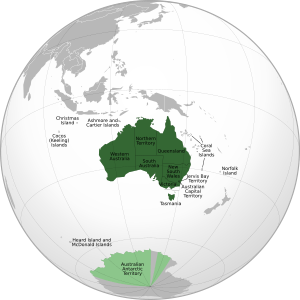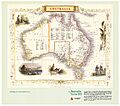States and territories of Australia facts for kids
Quick facts for kids States and territories of Australia |
|
|---|---|

Map depicting Mainland Australia’s states and its territories labelled in lime and dark green
|
|
| Location | Australia |
| Number | 16 (6 states, 3 internal territories, and 7 external territories) |
| Populations | Least populous state:
|
| Areas | Smallest state:
|
| Subdivisions | Local government areas and unincorporated areas |
Australia is a large country made up of different parts called states and territories. Think of them like big regions, each with its own government, but all working together under one main Australian Government. There are six states and ten territories. States have more power to make their own rules, while territories are more directly managed by the main Australian Government.
Australia has six states: New South Wales, Queensland, South Australia, Tasmania, Victoria, and Western Australia. It also has ten federal territories. Three of these are internal territories located on the mainland: the Australian Capital Territory, the Jervis Bay Territory, and the Northern Territory. The other seven are external territories, which are islands or land far away from the mainland. These include the Ashmore and Cartier Islands, the Australian Antarctic Territory, Christmas Island, the Cocos (Keeling) Islands, the Coral Sea Islands, Heard Island and McDonald Islands, and Norfolk Island.
Most states and internal territories (except Jervis Bay) manage their own affairs with their own leaders, lawmakers, and courts. The other territories are mostly looked after by the main Australian Government.
The main Australian Government and the state and territory governments all have rules they must follow, set out in the Australian Constitution. The highest court in Australia, the High Court of Australia, can make final decisions on all legal matters.
The Australian Capital Territory (ACT) and Northern Territory act a lot like states, even though they are technically territories. They have their own governments and representatives in the main Australian Parliament.
Contents
Australia's Geography
Australia is surrounded by the Indian, Pacific, and Southern oceans. It is separated from nearby countries like Maritime Southeast Asia and New Guinea by seas like the Arafura Sea, Timor Sea, and Torres Strait. It's the world's smallest continent and the sixth-largest country by land area. Australia has a long coastline of about 32,994 kilometers.
How States and Territories Were Formed
Before 1901, Australia was a collection of separate British colonies. Each colony had its own rules and leaders.
- The Colony of New South Wales was the first, started in 1788. It was very large, covering much of eastern Australia and even New Zealand and Tasmania.
- Over time, new colonies were created from parts of New South Wales. These included Tasmania (originally Van Diemen's Land) in 1825, Western Australia in 1829, South Australia in 1836, Victoria in 1851, and Queensland in 1859.
- In 1901, these six colonies joined together to form the Commonwealth of Australia. They became the first six states. This event is called Federation.
- The Australian Capital Territory (ACT) and the Northern Territory were created later by the Australian Parliament. The ACT was formed in 1909 to be the home of Australia's capital city, Canberra.
States have powers protected by the Australian Constitution. This means the main Australian Government can only make laws for states on certain topics. Territories, however, are more directly controlled by the main Australian Government. Even if a territory has its own government, the Australian Parliament can still change its laws.
Each state has a Governor, who is the King's representative and acts on the advice of the state's leader. The Northern Territory has an Administrator, appointed by the Governor-General. The ACT has its own system, where the local assembly and its leader handle these roles.
The Jervis Bay Territory is a special case. It's an internal territory but doesn't govern itself. Its laws are mostly based on the ACT's laws, but its residents are represented in the main Australian Parliament as part of the ACT.
States of Australia
Here's a quick look at Australia's states:
| Flag | State | Postal Code | ISO Code | Capital City | Population (June 2024) |
Area (km2) | Population Density (/km2) | Members in House of Reps. |
Governor | Premier (Party) |
State Government | |
|---|---|---|---|---|---|---|---|---|---|---|---|---|
 |
New South Wales | NSW | AU-NSW | Sydney | 8,511,151 | 800,150 | 10.49 | 46 | Margaret Beazley | Chris Minns (Labor) | Government of New South Wales | |
 |
Victoria | VIC | AU-VIC | Melbourne | 7,012,962 | 227,416 | 30.18 | 38 | Margaret Gardner | Jacinta Allan (Labor) |
Victorian Government | |
 |
Queensland | QLD | AU-QLD | Brisbane | 5,608,666 | 1,729,742 | 3.18 | 30 | Jeannette Young | David Crisafulli (Liberal National) | Queensland Government | |
 |
Western Australia | WA | AU-WA | Perth | 2,981,752 | 2,527,013 | 1.15 | 16 | Chris Dawson | Roger Cook (Labor) |
Government of Western Australia | |
 |
South Australia | SA | AU-SA | Adelaide | 1,882,722 | 984,321 | 1.89 | 10 | Frances Adamson | Peter Malinauskas (Labor) | Government of South Australia | |
 |
Tasmania | TAS | AU-TAS | Hobart | 575,959 | 68,401 | 8.89 | 5 | Barbara Baker | Jeremy Rockliff (Liberal) |
Tasmanian Government | |
Internal Territories
These territories are located on the Australian mainland.
| Flag | Territory | Postal Code | ISO Code | Capital City (or largest town) |
Population (June 2024) |
Area (km2) | Population Density (/km2) | Members in House of Reps. |
Administrator | Chief Minister (Party) |
Territory Government | |
|---|---|---|---|---|---|---|---|---|---|---|---|---|
 |
Australian Capital Territory | ACT | AU-ACT | Canberra | 475,644 | 2,358 | 198.97 | 3 | None | Andrew Barr (Labor) |
ACT Government | |
 |
Northern Territory | NT | AU-NT | Darwin | 255,559 | 1,347,791 | 0.19 | 2 | Hugh Heggie | Lia Finocchiaro (Country Liberal) |
Northern Territory Government | |
| None | Jervis Bay Territory | ACT | N/A | Jervis Bay Village | 405 | 67 | 6.04 | Part of ACT's Division of Fenner | Administered by the Department of Infrastructure, Transport, Regional Development, Communications, Sport and the Arts | |||
External Territories
These territories are usually islands located far from the Australian mainland.
| Flag | Territory | Postal Code | ISO Code | Capital City (or largest town) |
Population (Jun 2018) |
Area (km2) | Population Density (/km2) | Members in House of Reps. |
Administrator | Head of Local Government | Local Government |
|---|---|---|---|---|---|---|---|---|---|---|---|
 |
Norfolk Island | NSW | NF | Kingston | 2,601 | 35 | 74 | Part of ACT's Division of Bean | George Plant | Lead Administrator Scott Mason |
Norfolk Island Regional Council |
 |
Christmas Island | WA | CX | Flying Fish Cove | 1,938 | 135 | 14 | Part of NT's Division of Lingiari | Farzian Zainal | Shire President Gordon Thompson |
Shire of Christmas Island |
 |
Cocos (Keeling) Islands | WA | CC | West Island | 547 | 14 | 39 | Shire President Aindil Minkom |
Shire of Cocos (Keeling) Islands | ||
| None | Australian Antarctic Territory | TAS | AQ | None (Davis Station) |
60 | 5,896,500 | 0.0000102 | N/A | None | ||
| Coral Sea Islands | QLD | N/A | None (Willis Island) |
4 | 780,000 | 0.000005 | |||||
| Ashmore and Cartier Islands | N/A | None (offshore anchorage) |
0 | 199 | 0 | ||||||
| Heard Island and McDonald Islands | TAS | HM | None (Atlas Cove) |
0 | 372 | 0 | |||||
Each external territory has its own laws set by the main Australian Parliament. The Cocos (Keeling) Islands and Christmas Island are known as the Australian Indian Ocean Territories. People living there can vote in federal elections.
Norfolk Island's status has been a topic of discussion. The government has taken steps to integrate it more closely with Australia.
Former Territories
Australia once had other territories that no longer exist in the same way.
Former Internal Territories
Two internal territories that were once part of the Northern Territory no longer exist:
- Central Australia (1926–1931): This was the southern part of the current Northern Territory.
- North Australia (1926–1931): This was the northern part of the current Northern Territory.
Former External Territories
Two countries that are now independent were once managed by Australia as external territories:
Papua New Guinea (1883–1975)
Parts of what is now Papua New Guinea were managed by Australia for many years.
- The Territory of Papua was an Australian external territory from 1902 to 1949.
- The Territory of New Guinea was managed by Australia after World War I, from 1920 to 1949.
After World War II, these two territories were joined together for administrative purposes. In 1975, Papua New Guinea became an independent country.
Nauru (1920–1968)
The island of Nauru was also managed by Australia, along with Britain and New Zealand, after World War I. After World War II, it became a United Nations trust territory under Australian control. Nauru gained its independence in 1968.
Population and Area Statistics
Most Australians live in the eastern coastal states of New South Wales, Queensland, Victoria, and the Australian Capital Territory. These areas together hold more than three-quarters of Australia's population. Most major cities are located along the eastern and southern coasts.
| State / territory | Abbreviation | Land area |
|
Population density |
|
Notes | ||||||
|---|---|---|---|---|---|---|---|---|---|---|---|---|
| km2 | sq mi | Rank | Number | Rank | /km2 | /sq mi | Rank | % | Rank | |||
| NSW | 801,150 | 309,330 | 5 | 8,072,163 | 1 | 9.62 | 24.9 | 3 | 63.0% | 5 | ||
| VIC | 227,444 | 87,817 | 6 | 6,503,491 | 2 | 26.56 | 68.8 | 2 | 71.0% | 4 | ||
| QLD | 1,729,742 | 667,857 | 2 | 5,156,138 | 3 | 2.79 | 7.2 | 5 | 46.0% | 7 | ||
| WA | 2,527,013 | 975,685 | 1 | 2,660,026 | 4 | 1.03 | 2.7 | 7 | 73.4% | 3 | ||
| SA | 984,321 | 380,048 | 4 | 1,781,516 | 5 | 1.74 | 4.5 | 6 | 73.5% | 2 | ||
| TAS | 68,401 | 26,410 | 7 | 557,571 | 6 | 7.58 | 19.6 | 4 | 41.0% | 8 | ||
| ACT | 2,358 | 910 | 8 | 453,890 | 7 | 167.6 | 434 | 1 | 99.6% | 1 | ||
| NT | 1,347,791 | 520,385 | 3 | 232,605 | 8 | 0.18 | 0.47 | 8 | 54.0% | 6 | ||
Images for kids




